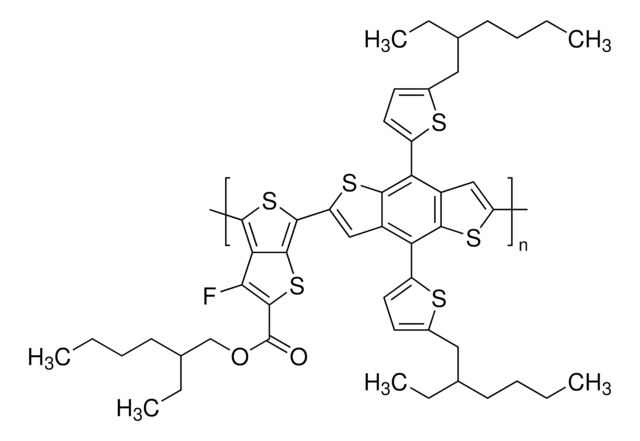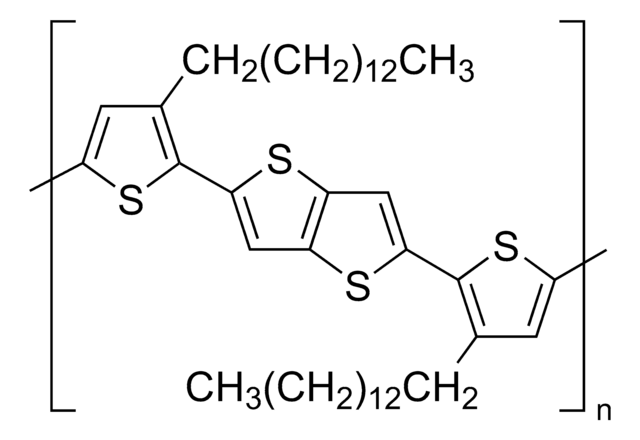753998
PCDTBT
Sinônimo(s):
Poly[N-9′-heptadecanyl-2,7-carbazole-alt-5,5-(4′,7′-di-2-thienyl-2′,1′,3′-benzothiadiazole)], Poly[[9-(1-octylnonyl)-9H-carbazole-2,7-diyl]-2,5-thiophenediyl-2,1,3-benzothiadiazole-4,7-diyl-2,5-thiophenediyl]
About This Item
Produtos recomendados
descrição
Band gap: 1.9 eV
Formulário
solid
peso molecular
average Mw 100,000-140,000
perda
0.5 wt. % TGA, 409 °C
pf
270-300 °C
temperatura de transição
Tm >400 °C
λmax
576 nm
Energia orbital
HOMO -5.5 eV
LUMO -3.6 eV
Desempenho do dispositivo OPV
ITO/MoO3-Al/PCDTBT:PC71BM/MoO3/Al
ITO/PEDOT:PSS/PCDTBT:PC71BM (1:4)/TiOxAl
ITO/PEDOT:PSS/PCDTBT:PC71BM/Al
propriedades semicondutoras
P-type (mobility=6×10−5 cm2/V·s)
Procurando produtos similares? Visita Guia de comparação de produtos
Descrição geral
Aplicação
Código de classe de armazenamento
11 - Combustible Solids
Classe de risco de água (WGK)
WGK 3
Ponto de fulgor (°F)
Not applicable
Ponto de fulgor (°C)
Not applicable
Escolha uma das versões mais recentes:
Já possui este produto?
Encontre a documentação dos produtos que você adquiriu recentemente na biblioteca de documentos.
Artigos
The development of high-performance conjugated organic molecules and polymers has received widespread attention in industrial and academic research.
Optoelectronic Devices Based on Diketopyrrolopyrrole (DPP)-containing Conjugated Small Molecules
Organic photovoltaics (OPVs) represent a low-cost, lightweight, and scalable alternative to conventional solar cells. While significant progress has been made in the development of conventional bulk heterojunction cells, new approaches are required to achieve the performance and stability necessary to enable commercially successful OPVs.
There is widespread demand for thin, lightweight, and flexible electronic devices such as displays, sensors, actuators, and radio-frequency identification tags (RFIDs). Flexibility is necessary for scalability, portability, and mechanical robustness.
Nossa equipe de cientistas tem experiência em todas as áreas de pesquisa, incluindo Life Sciences, ciência de materiais, síntese química, cromatografia, química analítica e muitas outras.
Entre em contato com a assistência técnica




![[6,6]-Phenyl C71 butyric acid methyl ester, mixture of isomers 99%](/deepweb/assets/sigmaaldrich/product/structures/716/624/9fb9f2f0-ae99-429f-8d3a-b12267976a4d/640/9fb9f2f0-ae99-429f-8d3a-b12267976a4d.png)



